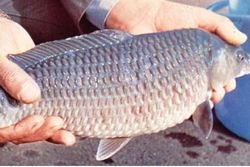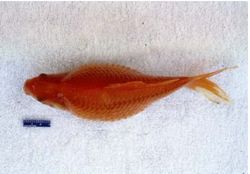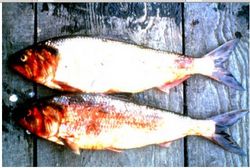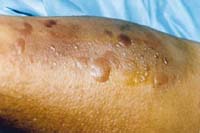Aeromonas
A Microbial Biorealm page on the genus Aeromonas

Classification
Higher order taxa
Bacteria; Proteobacteria; Gammaproteobacteria; Aeromonadales; Aeromonadaceae; Aeromonas
Species
Aeromonas hydrophila subsp. decolorationis Aeromonas hydrophila subsp. dhakensis Aeromonas hydrophila subsp. hydrophila
Description and Significance
Aeromonas hydrophila is a species of gram-negative bacteria. These organisms are oxidase-positive and facultatively anaerobic. Aeromonas hydrophila is a member of the family Aeromonadaceae, and is only one of six species Aeromonas species that are known to be pathogenic in humans. It is also pathogenic in fish.
Genome Structure
Some of the genes in Aeromonas hydrophila contribute to its toxicity. The cytotoxic enterotoxin gene (act), a single-chain polypeptide, is one of the primary genes that makes this species pathogenic. Heat-labile cytotonic enterotoxins (Alt), a heat-stable cytotonic enterotoxins (Ast) also have genes that contribute to toxicity. These are labeled alt and ast, respectively. Albert et. al. (2000) noted that three distinct genes code for these enterotoxins: act, alt and ast.
Cell Structure and Metabolism
Aeromonas hydrophila are rod-shaped and have polar flagella. The toxicity of this species comes from its strucure. For example, one important cell component is an aerolysin-related cytotoxic enterotoxin (Act) gene. This has the ability to lyse red blood cells as well as causing tissue damage. The work of Chopra et. al. (2000) illustrates other functions of Act. For example, Act activates arachidonic acid (AA)
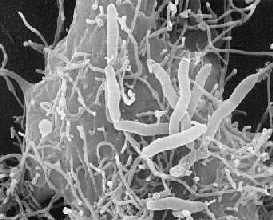
metabolism in macrophages. It also increases cyclic AMP (cAMP) production in macrophages. Albert et. al. (2000) found other factors contributing to the virulence of Aeromonas hydrophila: a heat-labile cytotonic enterotoxin (Alt), and a heat-stable cytotonic enterotoxin (Ast). Aeromonas hydrophila also excretes extracellular protiens which are toxic to other cells. These are aerolysin, glycerophospholipid:cholesterol acyltransferase (GCAT), and serine protease. Another major chemical that contributes to pathogenicity is hemolysin.
A. hydrophila are heterotrophic organisms. They can exist in both aerobic and anaerobic environments, and ferment glucose. A. hydrophila can also digest gelatin, hemoglobin, and elastin. They are opportunistic pathogens. A. hydrophila has fimbriae (pili), which help the bacteria attach to host organisms and invade cells. Act and aerolysin are activated when A. hydrophila attach to organs or cells. In animals such as fish, the bacteria can adhere directly to cell lines that have mucous receptors. A. hydrophila can travel via the bloodstream to any organ in the body. The bacteria then colonize the host organism, reproducing asexually. These bacterium do not produce spores.
Ecology
Aeromonas hydrophila can be found in aquatic environments as well as in food, and can be found worldwide. It can cause both intestinal and nonintestinal infections in humans, and can often be fatal. Some of the diseases that Aeromonas hydrophilia and other Aeromonas species can cause include: septicemia, meningitis, pneumonia, and gastroenteritis. There are many factors influencing the toxicity of Aeromonas hydrophila. For example, this species is able to resist complement-mediated lysis. It has been suggested that Aeromonas hydrophila causes human diarrhea, but this has not yet been verfied. The research of Albert et. al. (2000) indicates mixed infections, which has been illustrated in a previous study as well. This finding suggests that Aeromonas organisms are not true pathogens, but work with others to produce infection. There are three major wound infections caused by Aeromonas hydrophila: cellulitis, myonecrosis, and ecthyma gangrenosum. Cellulitis is the most common, an occurs as the result of injury or sepsis. Myonecrosis and ecthyma gangrenosum are less common, and tend to occur in immunocompromised individuals. However, Aeromonas hydrophila is a very prevalent species, and is capable of affecting immunocompetent people as well. At one point, it was believed this species did not pose a threat to healthy individuals, but the work of Chopra and Houston (1999) illustrates that Aeromonas hydrophila is more harmful than was previously believed. Aeromonas hydrophila is resistant to many common antibiotics such as penicillin and ampicillin. It is also resistant to refridgeration and able to grow at low temperatures. It can also thrive at warmer tempreatures, growing at 37 degrees celsius as well as it can at 25 degrees celsius. Aeromonas hydrophila are resistant to chlorine.
Because it is so prevalent in aquatic environments, Aeromonas hydrophila can cause serious pathology in fish. It can cause tail rot, fin rot, hemorrahagic septicemia, scale protrusion disease, and ulcer disease. Systemic infections usually attack the liver or kidneys. Aeromonas hydrophila is also responsible for a disease called Red Leg, which occurs in Xenopus species of frogs. This disease causes internal hemorrhaging, and is often fatal. It is similar to hemorrhagic septicemia, which is also known as Red-Sore Disease. However, Aeromonas hydrophila is naturally found in fish gut. Infection from this bacteria is usually the result of stress.
| Scale protrustion on a carp infected with Aeromonas hydrophila. "Aeromonas hydrophila and Motile Aeromonad Septicemias of Fish" by Rocco C. Cipriano. | Abdominal distension of a goldfish infected with Aeromonas hydrophila. "Aeromonas hydrophila and Motile Aeromonad Septicemias of Fish" by Rocco C. Cipriano. | Hemorrhage and ulcers on American shad, caused by Aeromonas hydrophila. "Aeromonas hydrophila and Motile Aeromonad Septicemias of Fish" by Rocco C. Cipriano. |
| A forearm showing symptoms of myonecrosis. Photo by D.R. Haburchack. | A forearm infected with cellulitis. Photo by D.R. Haburchack. | A leg infected with ecthyma gangrenosum, caused by Aeromonas hydrophila. Photo from Medscape. |
References
Arrow Scientific. Aeromonas hydrophila.
Hayes, John. Aeromonas hydrophila.
Northwest Fisheries Science Center.
Public Health Agency of Canada. Material Data Safety Sheet - Infectious Substances.
Rand, Marsha and Jennifer Kalishman. Xenopus Care, Health and Disease: A Brief Overview.
White, Randy. Diagnosis Of Aeromonas hydrophila Infection In Fish.
